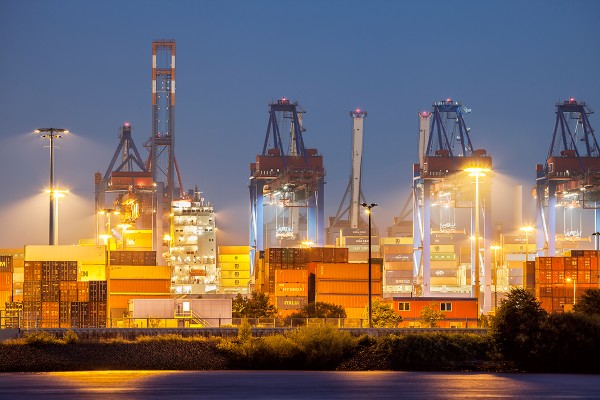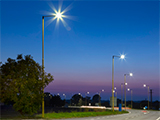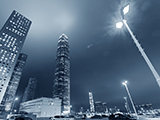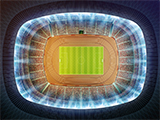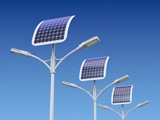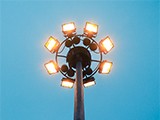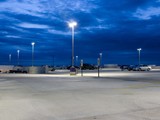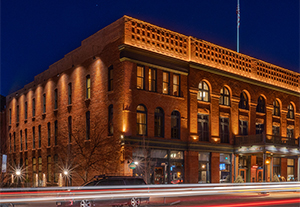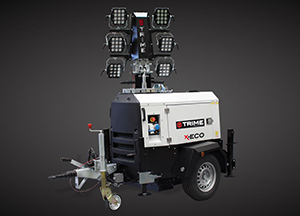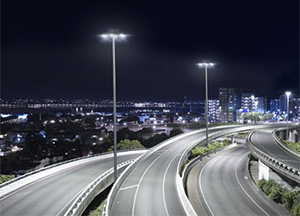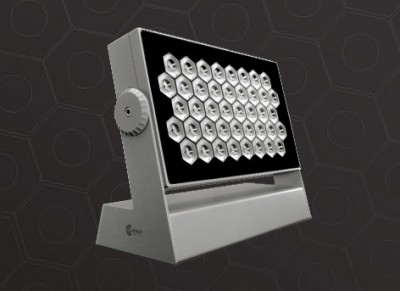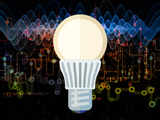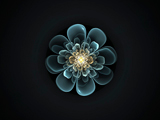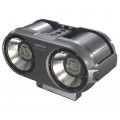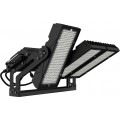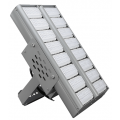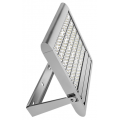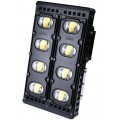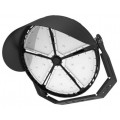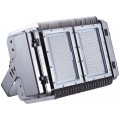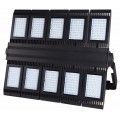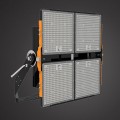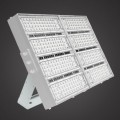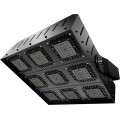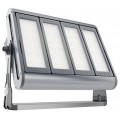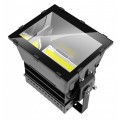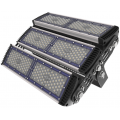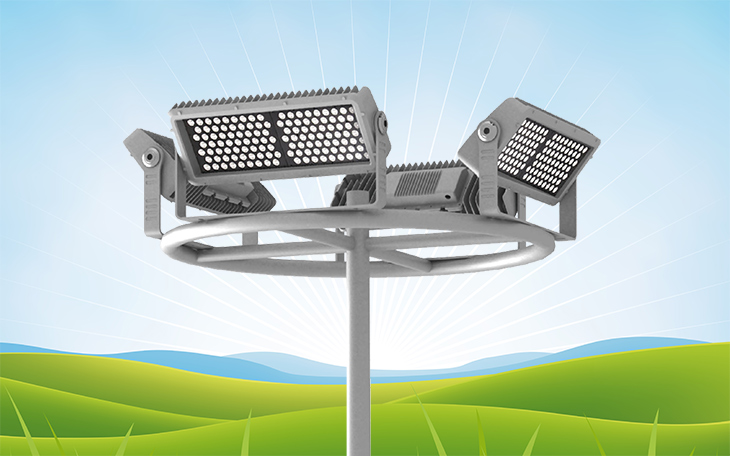
HID Lighting Disadvantages
Industrial and outdoor lighting applications that require high intensity illumination had previously been served by fixtures using what are known as high-intensity discharge (HID) lamps that include, but are not limited to, metal halide (MH), mercury vapor (HgV), high pressure sodium (HPS), and low pressure sodium (LPS). While high wattage (e.g., 1000 watt or more) HID floodlights produce a significant amount of light, their inherent disadvantages limit their application to outdoor lighting. HPS lamps, for example, have a larger light spectrum but lower efficiency (amount of light delivered vs. amount of light produced) and poorer depiction than other light sources. The metal halide lamp, though used widely used in sports and other wide-area lighting applications, suffers from several disadvantages. HID lamps require a long warm-up/start-up time of several minutes before providing usable light. A metal halide lamp produces light by passing a quartz or ceramic arc tube through a gaseous mixture of vaporized mercury and metal halides. A cold metal halide lamp cannot immediately generate its full light capacity and requires approximately 5 minutes before the electric arc between the electrodes emits visible light to full brightness. Hot restrike is of greater concern than long initial startup. It may can take up to 20 minutes to restrike the arc if the power is interrupted because the high pressure inside the arc tube may reach 440 psi (30 bar) which will prevent re-striking the arc. In addition to having a limited life span of approximately 3,000 hours for high wattage applications and poor lumen maintenance, metal halide lamps contain a significant amount of mercury and are prone to risk of explosion.
High Power LED Floodlighting
Many of these deficiencies in HID floodlights create a need for a better lighting system for high power applications. The progress in solid state lighting technology has been breathtaking during the last few decades. The increased efficiency, extended lifetime, and other advantages of LEDs (light-emitting diodes) is desirable for many industrial and outdoor lighting applications that were previously the realm of HID lights. Compared with traditional light sources, LEDs have following features that make them viable for many lighting applications.
Economic Benefit
Economics plays a big part in industrial and commercial lighting applications. Energy consumption, resource conservation, maintenance, and long-term sustainability are important factors that should be taken into consideration for any lighting installation. High output lighting system consumes a considerable amount of electrical energy to produce light for high intensity wide area lighting. While HID floodlights have luminous efficacy (lumens per Watt, lm/W) comparable to LED counterparts - HPS lamps have an efficacy of 75 to 130 lm/W, LPS lamps have a high efficacy of 130 to 185 lm/W, and MH lamps have an efficacy average from 70 to 115 lm/W. High power LED luminaires, on the other hand, use semiconductors that are more efficient and durable, and can have L70 lifetimes up to 50,000 hours. L70 lifetime is defined by Illuminating Engineering Society Standard LM-80-08 and describes the expected number of operating hours until the light output has dropped to 70% of initial levels. MH lamps (and most HID lamps) exhibit lamp lumen depreciation (LLD) characteristic. They have an initial light output at rated wattage (luminous efficacy), but then the lumen depreciation occurs most rapidly during the first 100-200 hours of operation (e.g. 20% depreciation). Over the life of operation, the lamp usually slowly loses lumen output from LLD. A typical 1500W MH floodlights, for example, can lose up to around 50% of its initial light output over a 3000 hour cumulative operation life. This means LED lights have a far more longer usable time than MH lamps. Today's white LEDs have a luminous efficacy average from 120 to 150 lm/W. Moreover, it is practically possible to increase the luminous efficacies of high power LEDs to as high as 200 lm/W with further improvements in the underlying materials and design. The economic benefits of LED lighting is obvious in view of its increased efficiency, extended lifetime, negligible maintenance investment, and the dramatically cut lamp cost which leads to a shorter payback time.
Better Light Quality
Solid state lighting is very favorable in terms of high color rendering lighting, resulting in a high color rendering index (CRI) value in the range of 70-95. CRI is a measurement of color reproduction quality of artificial lighting products. Higher CRI means a better quality in that the artificial light is more natural and more likely to spot color discrimination (i.e., to perceive subtle difference in hue). The metal halide bulbs typically have a CRI of about 65 which is deficient in the rendering a colored surface. High CRI in some lighting applications like sports lighting is highly desired for televising sports events. The excellent color rendering capability of LED lighting enables spectators to see the activity on the field with bright and vivid colors, which allows objects to be distinguished even with subtle color shade differences. LED lighting is highly directional by nature. Unlike HID light bulbs that emit light in all directions, LEDs produce directional light with optical efficiencies of 80% to 90%. Typical losses of intensity for metal halide lamps range from 40% to 60% of the light generated. The high optical loss will tend to result in unwanted light pollution such as on-field glare, spill light, uplight, and halo effect light. LED lighting, on the other hand, produces a beam pattern that can be more easily varied and controlled to meet light quantity and uniformity specifications and is therefore useful and desirable in the lighting industry.
Beyond Operation Cost and Light Quality
LEDs are redefining the high power lighting technology. In addition to the aforementioned benefits of longer lifetime, lower operational cost, and better light quality, LED lighting offer many other advantages over traditional light sources. The LED is an instant start-up light source, which will eliminate the initial waiting period for HID lamps to start and restart. The solid-state nature of LED provides for greater resistance to mechanical shocks or vibrations, thereby improving its durability significantly. LED lights are fully dimmable without color variation. A specific light level can be obtained through the operation of changing luminance or brightness of an LED lamp. Moreover, metal halide bulbs that generate significant amounts of short wave ultraviolet light (UV) which can be dangerous to humans, LED. In contrast, an LED luminaire emits virtually no ultraviolet light and no infrared radiation. LEDs contain no mercury or any other hazardous materials and are therefore environmentally friendly.
Construction and Thermal Management
A high power LED flood light fixture generally consists of a housing and electrical (driver) compartment typically made from low copper die cast aluminum. The heavy duty aluminum flood housing is designed to accommodate all electrical and optical components. A metal core printed circuit board (MCPCB) provides the thermal connection between heat sink and LED package, electrical insulation and the transfer of electricity into the LEDs. A lens frame fixes a clear or prismatic lens made of tempered glass or impact resistant polycarbonate. The frame is then mechanically sealed with a silicone gasket for weather tight operation. One challenge in designing high power LED lighting fixtures is that the high power LEDs emit a high amount of heat. Hence, it may be advantageous to remove the heat generated by the LED from the LED semiconductor junction and maintain the internal temperature of the luminaire assembly below the maximum operating temperature so the electrical and electronic components therein maintain peak performance. Thermal management, therefore, has become increasingly important in high power LED lighting. LED floodlights feature cast aluminum heat sink behind the LED assembly to control heat buildup and dissipate heat. Heat sinks are thermal conduction pathways that is integrated into a lighting system to remove or redistribute thermal energy from LEDs through thermal conduction with these heat sources. The aerodynamic vents created by the heat sink fins generate efficient air flow and accelerate natural convection. Hot air converges smoothly into a fast laminar flow, quickly transferring heat to the ambient environment. Other thermal management strategies have utilized heat pipes that combines the principles of both thermal conductivity and phase transition heat transfer mechanism. The complete separation of the electrical compartment from the LED assembly keeps the driver and other control circuitry very cool, effectively maintaining the driver's service life in high ambient operating temperatures. The housing is pre-treated and powder-coated to resists extreme weather conditions without cracking or peeling and provide optimal color and gloss retention. The floodlight design is increasingly incorporating more aesthetic elements. The attractively styled contemporary design with smooth curves and contoured edges blend unobtrusively with the environment.
LED
The selection of high power LED arrays, modules, or field replaceable LED light engines depends on various design considerations, such as light quality, light output, operating temperature, luminous efficacy, LED drive current, and maintenance, etc. In general, high power LEDs are designed with low thermal resistance, high efficiency, high brightness, high reliability, and superior corrosion robustness. The transition from low- and mid-power LEDs to high-power devices has challenged the LED packaging industry to seek efficient thermal designs that function at higher forward currents and temperatures. Top LED brands such as OSRAM OSLON Square, CREE XLamp LEDs, Lumileds LUXEON Rebel LEDs, and Nichia high power LEDs have very mature designs for a wide range of industrial and outdoor applications where high light output, excellent optical characteristics and maximum efficacy are required. It's of extreme importance to minimize the thermal resistance from the solder point to ambient for efficient heat dissipation in order to optimize luminaire life, lumen maintenance and optical performance even in the highest ambient environment.
Optical Assembly
The optical assembly design challenges every floodlight fixture designer to satisfy the demands of the client and meet the parameters of different optical solutions. The primary optic is included in the LED package, and the secondary optics are part of the floodlight fixture and are designed to shape the radiation pattern, or beam pattern, maximize efficiency and application spacing. Secondary optics provide unique optical combination possibilities to modify the LED output beam such that the output beam of the floodlights efficiently meets the desired photometric specification. LED secondary optics include reflectors, lenses, total internal reflection (TIR) lenses, and diffusers. Lens has the excellent light-gathering ability to control the distribution of light rays at a small angle. While the reflector has the advantage to redirecting the flux (illuminance) and converging the rays at a large angle. A TIR lens is a combination of lens and reflector, using the principle of total reflection optics to collect and process light. For high voltage applications it is recommended to use PMMA (acrylic) or PC (polycarbonate) lens for their high mechanical strength, excellent optical properties, good thermal stability, high thermal conductivity, and low moisture and water absorbing capacity. In high power floodlighting, lenses and TIR lenses are often used for better uniformity and higher optical efficiency (at least 90% for most applications). It makes sense, however, to use a reflector design in some applications, e.g. sports lighting, to achieve a designed beam pattern and minimize spill light and glare.
| NEMA Beam Spread Classifications | ||
| Beam Spread Degrees | NEMA Type | Beam Description |
| 10°- 18° | 1 | Very narrow |
| 18°- 29° | 2 | Narrow |
| 29°- 46° | 3 | Medium narrow |
| 46°- 70° | 4 | Medium |
| 70°- 100° | 5 | Medium wide |
| 100°- 130° | 6 | Wide |
| 130° and up | 7 | Very wide |
Beam Patterns
Flood lighting optics are available in different light distributions (asymmetric, symmetric and antisymmetric) with different beam spreads to suit floodlighting, spotlighting, roadway and area lighting applications.
Spot - The spot distribution can be applied to installations where precise illumination and light control is required for small, confined space over long distances. Typical applications include accent lighting, tall facades, column grazing and flag poles.
Narrow - The narrow beam provides a concentrated distribution for applications where a tight symmetrical distribution is high desired. It is typically used for accenting landscape, monuments, storefronts and building facades.
Medium: The medium floods are designed for high intensity floodlighting or area lighting applications that require a wider uniform pattern in a designated coverage.
Wide - The wide beam floodlighting is designed for general floodlighting applications where broad, even illumination is required over a large area. Typical applications include pole mounted large area lighting and ground mounted, sign and facade lighting.
Horizontal - The horizontal flood projects a wide horizontal beam with a narrow vertical concentration. This distribution pattern is ideal for applications that require a vertical cutoff.
Vertical - The vertical flood beam spread is ideal for applications requiring a horizontal cutoff but vertically deep distribution.
LED Driver
The electrical assembly includes one or more LED drivers designed to operate the LEDs under wide temperature and electrical ranges to ensure reliability for the most rugged applications. The driver is designed to accept a universal input voltage e.g. 90-305V AC or 120-277V AC. System power factor is generally greater than 0.9 at full load. The total harmonic distortion, or THD, is required to not exceed 20% (a THD of less than 10% is exceptionally good). The driver is thermally protected from excessive temperature. The output overvoltage and overcurrent circuit provides protection against transient peak currents, transient voltage spikes and drops that can occur in electrical systems which would otherwise lead to burning up or premature LED failure without it. The driver components are encased in a IP66/67 water proof, flame resistant plastic enclosure.
Lighting Control
The implementation of controls in high power LED lighting offers many benefits such as energy savings, reduction in light pollution, extending the luminaire life and compliance with energy codes. LED drivers are generally equipped with dimming circuitry for 0/1-10V dimming, DALI digital dimming, or PWM dimming, to allow for adjustment of lighting levels. LED flood lights may also be controlled by motion sensors and are configured to illuminate from low to high power or turn on/on when motion is detected. A photocell can be installed to provide dusk-to-dawn illumination. Emery management system or addressable intelligent controls offers the greatest flexibility and provide multi-way communication channels for networked control. LED RGBW architectural flood lights, for example, can be operated under DMX512 consoles to create fixed or dynamic colorful lighting effects for flood, wash and accent lighting applications to enhance architectural features.
Related Products
LED Flood Lights
LED Architectural Floodlights
LED Roadway Lighting
LED Area Lights
LED High Mast Lights
Parking Lot Lights
LED Canopy Lights












